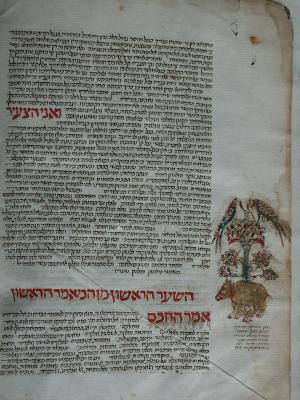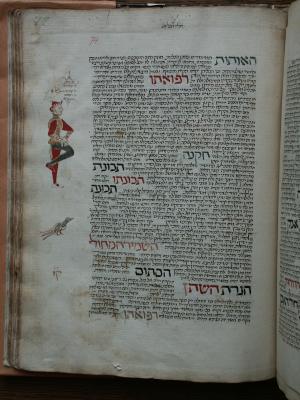Obj. ID: 26161
Hebrew Illuminated Manuscripts Vienna Sefer ha-Hefez ha-Shalem, Specchia (Italy), 1415

This medical manuscript copied in the city of Specchia (town in the Italian province of Lecce, Southern Italy) in 1415 contains the text of Sefer ha-Hefez ha-Shalem (fols. 1v-130v) and the beginning of Sefer ha-Shtanim (Book on Urine) (fol. 131v) by Isaac son of Solomon ha-Israeli (Egypt and North Africa, mid. 9th c.- mid. 10th c.).
Sefer ha-Hefez ha-Shalem is the Hebrew translation of the first two treatises of a medical encyclopedia written by the Muslim Al-Zaharāwī, more widely known by his Latin name Albucasis, in the year 1000 (Hamarneh and Sonnedecker, Pharmaceutical View of Abulcasis, pp. 13-22). These two treatises of the encyclopedia comprise the classification of 325 diseases and a discussion of medical treatment for each of them. The whole encyclopedia entitled "al-Tazrif" became one of the most influential medical text books in all of Europe and its parts were translated many times into Hebrew (Steinschneider, Die Hebraeischen Übersetzungen, pp. 745-747). The translation in the Vienna manuscript was carried out by Meshulam son of Yonah, a Jewish physician and translator who lived in the 13th century in Southern France (See: Hamarneh and Sonnedecker, Pharmaceutical View of Abulcasis, pp. 30-31; Lauterbach, "Meshullam ben Jonah", The Jewish Encyclopedia, vol. VIII, p. 503; Muntner, Shem Tov ben Isaac of Tortosa, p. 334).
The Vienna copy is one of five extant Hebrew copies of Sefer Ha-Hefez Ha-Shalem and the only one which is illuminated. Other copies are from Spain between 13th-15th centuries (13th century (Oxford, Bodleian Library, Laud. Or. 157 (F19934)); ca. 1370 (Paris, BN, Heb. 1167 (F15074)); 1452-3 (Paris, BN Heb. 1168 (F 37526)); 15th century (Paris, BN, Heb. 951/4 (F32602)), (see: The database of theInstitute ofMicrofilmed Hebrew Manuscripts in the Jewish National and University Library in Jerusalem).
According to David bar Elijah Nezer Zahav colophon (fol. 130v) and his note on fol. 129v, he copied the manuscript for his own use as a physician in 1415 inאיספקיאה דלמנדוליאה. The previous research's assumption was that the city Ispachia refers to Skopje, the capital of Macedonia(Schwartz, Catalogue, no. 181). This opinion was rooted in the incorrect reading of the word דלמנדוליאה (de la Mendolea) as דלמצדוליאה (de la Mezdolea), which was translated to Macedonia (מאצדוניה). The re-reading of the colophon with the help of Dr. Binyamin Richler, the former director of the Institute of Microfilmed Hebrew Manuscripts (of the Jewish National and University Library in Jerusalem) lead to the conclusion that the city is Specchia, situated in the province of Lecce in the region of Apulia. In the Middle Ages the city of Specchia was also called Specchia de Preyti de la Mendolea (this name appears in a document from 1511, see: Colafemmina, Ebrei e Cristiani Novelli in Puglia, p. 202, n. 16), which is closer to the correct reading of the colophon, i.e., Specchia de la Mendolea. The title Mendolea was given to the city because of the many almond trees found in the area, or perhaps after the name of the Roman matron – Lucrezia Amendolara, who according to legend founded the city. Therefore, the origin of the manuscript moves from Macedonia, westward, beyond the Adriatic Sea, to the city Specchia, being the only witness to the existence of the Jewish community there at the 15th century.
This manuscript is not the only extant manuscript copied by David bar Elijah Nezer Zahav. He copied and decorated one more manuscript, which is dedicated to astronomy (Vienna, Österreichische Nationalbibliothek, Cod. hebr. 57 (see documentation …). Despite the lack of a colophon, its scribe was identified by Schwartz as David bar Elijah Nezer Zahav on the basis of palaeographical comparison with the script in our medical manuscript. Also one of the owner's inscriptions inserted into its last astronomical table (fol. 111) but missed by Schwartz, supports his suggestion. In this inscription Yaakov Levi de Aragon informs us that the manuscript is of David son of Elijah [Nezer Zahav] (or it is also possible to read as: for or by David…), the physician and the leader of the Lecce Congregation. It was completed in1438 inLecceby Yaakov Levi himself (who completed the astronomical tables on fols. 103v-111, continuing the quire which David started).
David’s father, Elijah [Zebi] ben David [Ibn Muallem] Nezer Zahav (see: Zuckermann, Catalogue, p. 5, no. 37) was also a scribe who copied at least six manuscripts, the earliest one in Vlona in Albania in 1385 (Parma, Biblioteca Palatina, Cod. Parm. 2367) and the rest in Lecce in Southern Italy in 1386 (Torino, Biblioteca nazionale, A. VI. 41. The manuscript was burned. For details see: Palaeographical Project, Y 31), in 1400 (Parma, Biblioteca Palatina, Cod. Parm. 2373), in 1414 (Breslau, Jüdisch-theologisches Seminar, 37. The manuscript was also burned. For details see: Zuckermann, Catalogue, p. 5, no. 37), in 1415 (Breslau, Jüdisch-theologisches Seminar, 60), in 1425 (Oxford, Bodleian Library, MS Mich. 336). According to the colophons of these manuscripts we can learn that till 1414 Elijah Nezer Zahav copied manuscripts for himself, whereas from 1414 (Breslau, Jüdisch-theologisches Seminar, 37 and 60) he copied them for his son David the physician. It is quite possible that around 1414-1415 David really started to practice as a physician in Specchia and later moved to Lecce, where he enjoyed the high position of the head of the community. The subjects of the manuscripts copied by the father and the son are related to Torah, Halakha, Kabbalah, astronomy and of course medicine because of David's profession (for more information see the forthcoming publication Sternthal & Steimann, David Nezer Zahav)
As did David in his manuscripts, Elijah Nezer Zahav also embellished them with refined decoration and with human figures. Unavoidably, David's style is closely related to that of his father. For example, the man suffering from pain in the kidneys illustrating the symptoms of kidney disease in our manuscript (fig. 1) is similar to that of the figure of the scribe in one of Elijah's manuscripts (fig. 2). The similarity between the patient and the scribe is evident mostly in their faces. Both have long oval faces with the beard split in the middle, short hair stylized like a mushroom, closely set eyes and thick arched eyebrows.
|
Fig. 1: Kidney Disease (Vienna, Österreichische Nationalbibliothek, Cod. Hebr. 30, fol. 73). |
Fig. 2: The Scribe (Parma, Biblioteca Palatina, Parm. 2373, fol. 16v). |
sub-set tree:
Material: Parchment and paper II + 134 + II leaves. (Following the red foliation while the pencil foliation is not complete and skipped on fols. 5 & 6 though fol. 7 is foliated 5 and etc.)
It is easy to distinguish between hair and flesh sides of the parchment.
Watermark: a building and a leaf – Brique 6192 (Venedig 1410; Neapel 1414).
Measurements
|
Full page: (291-295) x (200-220) mm. Parchment leaves are smaller than the paper ones and their measurements are (255-268) x (200-212) mm (e.g. fol. 72). |
|
Text space: (197-212) x (129- 131) mm |
Scribes
Single scribe, David son of Elijah Nezer Zahav.
Script
|
The main text is written in semi-cursive Sephardic script in brown ink. |
Columns
The main text is written in one column; Table of contents (fols. 130-130v) is in two columns.
Number of lines
The main text is written in various numbers of lines, mainly between 50- 70 lines per page.
Ruling
Ruling by stylus 1 + 1 vertical lines and 1 + 1 horizontal lines (e.g. fols. 3, 13), and by plummet (e.g. fols. 23, 24, 24v, 39v, 40, 96).
Ruling for the table of contents: 2 + 1 + 1 + 2 vertical lines by stylus.
Pricking
Noticeable in all margins (fols. 3, 11, 13, 15, 18).
Quires
8 quires of 16 leaves each except for VII 18 and VIII 20.
Each quire consists of paper and parchment leaves in which the parchment bifolia are the outer one and the central.
Catchwords
Catchwords for the quires are written horizontally (e.g. fols.16v, 32v, 48v, 64v, 114v) and vertically (e.g. fols. 80v, 96v) at the end of each quire in the lower left-hand margin. Some are decorated (fols. 48v, 64v, 80v, 96v).
Catchword for each page is written in the middle of the lower margin in semi-cursive script..
Hebrew numeration
For the chapters, starting on fol. 19 with chapter 20 (“כ”) and ends on fol. 130 with chapter 195 ("קצה").
Blank leaves
Fols. 1, 131, 132-134v.
19th century binding with a stamp of: “Fr. Hollsteiner Buch binder in Wien.” Dark purple marble paper on the front and back cardboards, with white leather cloth covering the spine and the corners. The spine is decorated with a brown panel inscribed in gold-tooled letters: “Meschullam b. Iona Votum perfecti.” Above it is the Emblem of the Austrian Empire of Franz Josef.
The decoration is made by the scribe.
- Many marginal illustrations:
A. 14 text illustrations including: Parrots pecking a human head (fol. 2v), sweating bust of a woman (fol. 13), man suffering from kidney disease (fol. 73), man jumping to cure his kidney disease (fol. 74), bird flesh or ashes as a remedy for kidney disease (fol. 74), watermelon as a remedy (fol. 75), flask with urine or wine (fol. 75v), anus (fol. 77), androgynous (fol. 88), mermaid giving birth (fol. 88v), baby (fol. 91v), man suffers from arthritis (fol. 93v), herd of animals one should refrain from eating (fol. 97) and blood-letting (fol. 100). Most of the marginal illustrations are in bottle and olive green, ochre, magenta, dark and light blue and brown colours. Some are drawings in brown or red ink.
B. Various animals decorating the margins such as a bird (fols. 5v, 40, 56v, 92, 95v), owl (fol. 57v), parrot (fols. 1v, 2v, 61), eagle (fols. 61, 72), stork (fol. 5v), ostrich (fols. 47, 90), crane (fol. 48, 65), peacock (fol. 80v, 118), fish (fol. 43, 86), duck (fol. 83), lion (fols. 69v), tiger (fol. 46), cat (fol. 96v), dog (fols. 44v, 50, 98), deer (fol. 1v), wolf (fol. 58), wild boar (fol. 1v), monkey (fol. 81v) , elephant (fol. 70v) or a quadruped (fol. 96), hybrids (fols. 7, 10, 19v, 24v, 31, 33, 42), Pegasus (fol. 59), unicorn (fols. 71, 95) and dragons (fols. 7, 10, 33v, 42v, 89v, 129v); two chasing hyenas and a dog (fol. 9); cat with a mouse (fol. 84v), two heraldic lions (fol. 129v); human head (fol. 48v), and a musician (fols. 58, 92v, 97v).
C. Some illustrations decorate the chapter's numeration (e.g. fols. 29v (=hybrid), 31, 31v (=women bust), 33v, 40, 46 (=tiger), 47, 50 (=dog), 56v, 57v, 58 (=wolf), 59, 71, 72, 81v, 83) or titles (e.g. fols. 47v, 48, 48v, 81v).
- Rubrication mostly in black or red ink for each title (height of 3 lines), some are in blue, greenish-blue, purple, ochre, or green colours (e.g. fols. 44v, 71v, 92). Few titles are surrounded by wriggly and foliage motives (fols. 2v, 44v, 58)
- Pointed hand in the margins (e.g. fols. 8, 18v, 27, 43, 53, 92v, 93v, 94,).
- Decorated catchwords (fols. 48v, 64v, 80v (=peacock), 96v (=cat)).
- Decorated titles and chapter numeration by floral motives.





















